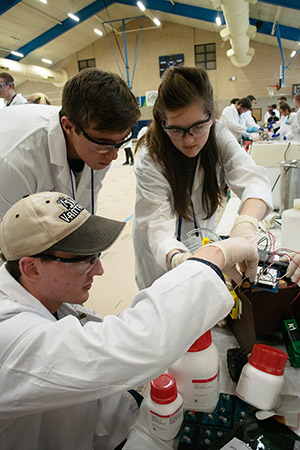
Contact Us
Institutional Communications
Bureau of Mines Building, Room 137
Laramie, WY 82071
Phone: (307) 766-2929
Email: cbaldwin@uwyo.edu
UW Students Place Seventh in ChemE Car Competition
Published April 18, 2019

UW engineering students (from left) Thomas Christensen II, Andrew Halverson and Amanda
Christensen prepare for the ChemE Car competition that was part of the recent AIChE
Rocky Mountain Regional Conference. The UW team took seventh place (out of 12 teams)
in the “race” portion of the competition and second place with the poster the team
presented with the car. (Kennedee True Photo)
Seven University of Wyoming engineering students recently competed in a car race. No one drove laps at 200 miles per hour on the NASCAR circuit. Rather, they competed against other schools with a shoebox-sized car that was fueled and stopped by chemical reactions.
The ChemE Car team, a group within UW’s chapter of the American Institute of Chemical Engineers (AIChE), recently competed at the AIChE Rocky Mountain Regional Student Conference at Colorado School of Mines April 5-6. The UW team, making its first appearance at the contest since 2014, took seventh place (of out of 12 teams) in the “race” portion of the competition, and second place with the poster the team presented with the car.
“Our car showcases Wyoming’s dominant industries by fueling the car with biohydrogen generated from cow rumen fluid (aka cud) while our stopping mechanism is basically an atomic clock, and uses a small quantity of cesium, a byproduct of Wyoming uranium mining,” says Amanda Christensen, a UW engineering student from Buford and a member of the ChemE Car team. “Our car is named ‘The ChemE Car That Cud.’ It’s a pun using the colloquial term for rumen fluid.”
Teams from AIChE chapters across the nation also built cars, with the goal of competing against each other at regional and, then, national contests organized at AIChE conferences. The rules for the contest stipulate that the car must be fueled and stopped solely by chemical reactions and must travel a distance between 15 and 30 meters with a load of 0-500 milliliters of water. Both parameters are decided upon and announced by officiants at the contest.
Once teams arrive at the contest, they have a maximum of three hours of access to their chemicals to get their reactions started and make adjustments necessary to stop the car at the appropriate distance.
“The goal of the competition is to design your car well enough that it stops closest to the distance goal announced at the contest,” Christensen explains.
Designing the car was not without its challenges.
“One of the big challenges another member of the team and I faced was programming our stopping mechanism in the MyRio computer. The programming language for this particular device is LabVIEW, which neither of us had any experience with,” says Seth Messick, a team member from Kemmerer. “However, Marvin Perry, who works in the machine shop, was able to teach us enough to help us figure it out.”
Team captain Thomas Christensen II, of Buford, says his biggest challenge was to convince others that their car was safe.
“We had both microbes and radioactive substances on our car, and that made some of our professors and technicians nervous,” he says. “Of course, microbes and radioactive substances are everywhere, and are much more dangerous in everyday life than in the systems we had.”
Thomas Christensen II says the team was able to demonstrate numerically that the cesium (a chemical element) used could only cause harm if someone sat on it for 20 years. The team got UW’s biosafety officer to sign off on the car, saying that rumen fluid was perfectly safe, he says.
Other team members include Kennedee True, of Casper; Andrew Halverson, of Green River; Caleb Richmond, of Rock Springs; Jake Maksin, of Thermopolis; and Alexander Brown, of Canmore, Alberta, Canada. David Bagley, a UW professor of chemical engineering, is the team’s faculty sponsor.
“The ChemE Car team is a good way to build experience with working in groups and to apply the things you learn in school to a real-life problem,” Halverson says.
“I have learned new things, like cows have four parts to their stomach,” Brown adds.
Contact Us
Institutional Communications
Bureau of Mines Building, Room 137
Laramie, WY 82071
Phone: (307) 766-2929
Email: cbaldwin@uwyo.edu
